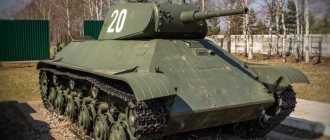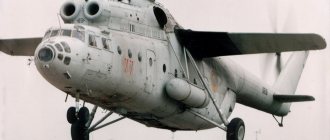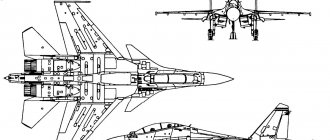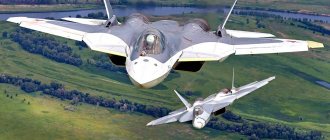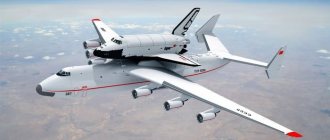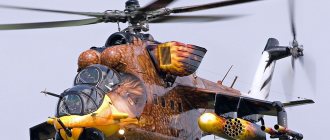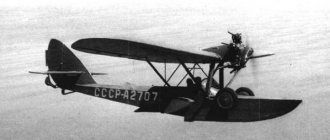PT-76 is the only example of a light amphibious tank created in the post-war period. It was put into service in 1951 and is considered the most widespread and successful in its class in the history of tank building. The impetus for the development of this vehicle was the acute shortage of transportation means and the lack of amphibious equipment in service in the Soviet Army. It was clear to the USSR government that in the event of an acute conflict with the West, military operations would take place in Central Europe, which is distinguished by a significant number of water barriers.
Tank PT-76 – video
The lack of floating equipment would significantly slow down the advance of Russian troops. That is why by the end of the 40s. XX century Various transportation means were developed and put into service, including cars and transporters. Work on the creation of an amphibious tank began with a government decree addressed directly to two design bureaus, which were located in Leningrad and Chelyabinsk. At the same time, they began to develop the “Object 740” and the amphibious armored personnel carrier “Object 750”, which later received the designation BTR-50. According to the order, the mass of the tank should not exceed 14 tons, in addition, it was assumed that the vehicle would reach speeds of up to 40 km/h on land and 10 km/h afloat and would be equipped with a 76-mm cannon. An experimental model of the tank was presented by the designers in the spring of 1950. In many qualities, the new vehicle exceeded the parameters set by the decree. On it, the designers used a number of units and components that had not previously been used for amphibious tanks: water-jet propulsion, a cooling system, an air purification system with automatic dust removal, and hydraulic shock absorbers.
Good speed, maneuverability on the water, and high cross-country ability even in bodies of water overgrown with bushes were fully ensured by water-jet propulsion. At the same time, the low specific pressure of the tracks on the ground ensured that the vehicle could easily overcome heavily swampy areas. In addition, it took up less space and was easy to maintain. The use of hydraulic shock absorbers coupled with an individual torsion bar suspension had a beneficial effect on the smoothness of the ride and increased the average speed of the tank, as well as shooting accuracy on the move. The vehicle was also equipped with a protection system against weapons of mass destruction and an automatic fire extinguishing device. The tank performed well in forced marches up to 510 km.
Armament
The vehicle was put into service under the designation PT-76, which stood for “amphibious tank with a 76-mm gun.” In addition to the main armament, the tank was equipped with a 7.62-mm SGMT machine gun, so the vehicle was capable of quite successfully performing fire missions in reconnaissance and landing operations.
Modifications
The produced modifications of the PT-76 mostly differed only in the type of weapon:
PT-76 Model 1 - with D-56T gun. Armor-piercing shell at 2000 m - 60 mm (armor at an angle of 60 degrees)
PT-76 Model 2 - with D-56TM gun. The muzzle brake on the gun has been modernized.
PT-76 Model 3 - with D-56TM gun. Double-chamber muzzle brake on the gun.
PT-76B Model 4 - with D-56TS gun. The gun is stabilized in two planes. The tank was produced from 1959 to 1963.
PT-76M is an experimental vehicle based on the PT-76B. It was made in a single copy, which failed the tests due to insufficient seaworthiness.
The AU-220M combat module was developed in the 2000s by the Burevestnik Central Research Institute. The module consists of a 57-mm BM-57 automatic cannon based on the S-60 anti-aircraft gun) and a coaxial PKT machine gun with an upgraded fire control system. The developers of the AU-220M are already proposing to install this unit on the PT-76 amphibious tank as the main weapon during modernization. For the first time, a prototype equipped with a combat module with a 57-mm automatic cannon was presented in 2013 in Nizhny Tagil at the Russian Expo Arms-2013 defense exhibition.
The tank was produced in Poland under the name PT-76. A later modification added another 7.62 mm machine gun and separate hatches for the commander and gunner.
In Indonesia, in the late 1990s, the PT-76s were modernized with new engines, transmissions and 90-mm Kokkeril guns. These vehicles are designated in Western press as PT-2000.
Surveillance and communications equipment
In non-combat conditions, the commander of the PT-76 can monitor the terrain while standing in the open hatch. In combat, in addition to the sight, the commander has three periscope viewing devices located in the rotating commander's cupola. The devices are installed in a dense group and provide visibility only into a relatively narrow sector. The main one on tanks of early releases was the binocular commander TPKU, on PT-76 of later releases and PT-76B it was replaced by the slightly different TPKU-2. Both devices have a 5× magnification and a field of view of 7.5° horizontally, allowing observation at a distance of up to 3000 meters and are equipped with a coordinate grid for target designation and fire adjustment, as well as a rangefinder scale for determining the range to a target of known height - 2.7 m ("tank"). On the sides of it there are two prismatic periscope TNP devices of single magnification.
The loader for viewing the terrain in battle has only one rotating periscope MK-4 single-magnification device, located in the turret roof in front of the hatch. The driver-mechanic on the march conducts observation through the open hatch, but in combat, to view the terrain, he is served by three TNP devices, located like a fan in front of the hatch and providing visibility of the frontal sector. For observation afloat with the wave-reflective flap raised, early production tanks use periscope devices PER-17 or PER-17A, later replaced by TNP-370. To drive the tank at night, the PT-76 of later releases and the PT-76B are equipped with a TVN-2B binocular night vision device, which is installed in place of the central TNP. TVN-2B is an electro-optical device that works by illuminating the FG-100 headlight, or, on the PT-76B, FG-125 with an infrared filter, providing the driver with a vision range of 50-60 m and a field of view of 30° at one-time magnification. The remaining crew members do not have any night vision devices.
Combat use
PT-76s were widely used in a number of armed conflicts, including the Vietnam War, the conflicts between Israel and Syria and Egypt in 1967 and 1973, the Indo-Pakistan War of 1971, the Yugoslav War of 1991-1995, and occasionally during fighting in Chechnya.
Vietnam War
The first major clash of Vietnamese tanks with American tanks took place on March 3, 1969. The 4th battalion of the 202nd tank regiment, with 12 PT-76 tanks and several BTR-50PK armored personnel carriers, attacked the American Ben Het camp. The goal of the attack was to destroy the positions of the battery of 175-mm M107 self-propelled guns. The lead PT-76 hit a mine, but its crew continued to fire cannon fire at the enemy. The remaining tanks were met by a platoon of M48 Pattons from the 69th Tank Regiment of the US Army and two M42 anti-aircraft self-propelled guns. One M48 was hit in the turret by a PT-76 shell. Another Patton destroyed one Vietnamese tank with return fire. The attack fizzled out after the loss of two PT-76s and one BTR-50PK.
PT-76, shot down in the battle of the Ben Het special forces camp, South Vietnam, 1969
Indo-Pakistan War 1965
Since the spring of 1965, attacks by the Pakistani side on the border have become more frequent, as a result, India turned to the Soviet Union for protection from a possible invasion. India received the first PT-76 tanks in August 1965. Before the start of the war, India had two regiments of such tanks, consisting of about 90 pieces. At first, Indian soldiers called new tanks of unknown design “Patton”.
On September 21, Company C of the 7th Regiment, armed with PT-76s, counterattacked the village of Tatti Jaimal Singh, which had been captured by the Pakistanis. During the battle, Indian PT-76s knocked out the Pakistanis from the village, knocking out one Patton, one Sherman and capturing 2 jeeps with 106-mm M40 guns and 2 trucks with ammunition, in turn, the Pakistanis managed to knock out one Indian tank. Total Indian casualties during the war were around a company of PT-76s, mostly abandoned, 6 or 7 of which were captured by the Pakistanis.
Indo-Pakistan War 1971
Indian and Pakistani PT-76s took part in the 1971 war. The Indians deployed two regiments and 2 independent squadrons of such tanks on the eastern front (in total, the Indians had about 150 such tanks), the Pakistanis had 6-7 PT-76s. In total, about 150 Indian tanks and 75 Pakistani tanks collided on the Eastern Front. Almost all units armed with the PT-76 were concentrated against the Pakistani group in East Bengal. Amphibious tanks were ideally suited for operations in the Ganges Delta.
On December 9, a company from the 1st separate squadron with Gurkha riflemen on armor broke through to the docks of the port of Chandpur. At this time, three river gunboats with 450 soldiers were moving along the Meghna River towards Dhaka. PT-76 opened fire. All three gunboats were sunk, with only 180 Pakistani soldiers surviving. On December 11, the same tanks sank another Pakistani ship, killing 83 Pakistani soldiers and capturing 33.
A day later, on another section of the front, PT-76s of the 69th Tank Regiment, again with Gurkha infantry on the armor, made a flanking maneuver. Having walked 55 km through the swampy jungle, crossing several rivers, they occupied the city of Bogra with an unexpected attack on December 12. During the assault, 76-mm cannon fire destroyed an M24 Chaffee tank, two 106-mm M40 recoilless rifles, and captured 55 3-ton trucks.
During two weeks of fighting, 13 Indian PT-76 tanks were destroyed and damaged. The Pakistanis lost all the tanks they had in East Pakistan, 66 M24 Chaffee and 6-7 PT-76. Indian PT-76s made one of the most significant contributions to the victory.
PT-76 in Cambodia
Six Day War
Egyptian PT-76s took part in the 1967 war. They were misused and without much success. As a result of the battles, out of 29 PT-76s, only 2 were destroyed and 7 were abandoned. 7 captured amphibious tanks were commissioned by the 88th reconnaissance battalion of the Israeli army. The engines on these vehicles were replaced, American machine guns and new radio stations were installed.
Yom Kippur War
PT-76 tanks participated on both sides in the Yom Kippur War of 1973. On the night of October 16, Israeli PT-76s began an operation that became a turning point in the war. 7 tanks and 8 BTR-50P with motorized infantry from the 11th reserve tank brigade of Colonel El Gonen crossed in the northern part of the Great Bitter Lake to its western shore and captured a bridgehead in the area of Abu Sultan station. Over the next two days, Israeli troops attacked the right-flank units of the 2nd Egyptian Army, pushing them towards the canal. By the end of October 18, up to 200 tanks were deployed to support the landing. On the morning of October 19, the troops located on the bridgehead launched a decisive offensive. Its feature was the widespread use of tanks in small groups (up to a company with motorized infantry and ATGMs on armored personnel carriers). Operating on a wide front, they found weak spots in the defenses of the Egyptian troops and broke through to the rear. Light tanks PT-76 reached the positions of air defense systems and radars at high speed and, destroying them, contributed to the successful actions of aviation. By the end of October 20, there were three armored and two mechanized brigades of the Israel Defense Forces on the bridgehead, which by the end of the day on October 21 expanded the bridgehead along the front to 30 km and 20 km in depth and continued the offensive.
History of creation
Even before World War II, amphibious tanks were actively developed in the USSR. By the beginning of the war, work on them was stopped, as much more important tasks appeared before the designers. By 1941, the USSR had the world's largest fleet of amphibious tanks, but almost all of them were lost at the beginning of the war. And the reliability and combat capabilities of these vehicles left much to be desired.
After the end of the war, the problem of the lack of amphibious equipment had to be solved. This was especially relevant because in the event of a conflict with Europe, they would have to fight on their territories, where there are a lot of water barriers.
In 1949, work began on two new vehicles at once: the Object 740 amphibious tank and the Object 750 amphibious armored personnel carrier, which later became the BTR-50.
By the spring of 1950, a prototype of the amphibious tank was completed, and it was immediately sent for state tests. Also by the same time, a similar tank from another plant, the K-90, was completed.
In comparative tests, the Object 740 showed that it is much more capable than the K-90, and at the same time exceeds the issued requirements in almost all respects. As a result, in 1951, the Object 740 was accepted into service, calling it PT-76, an amphibious tank with a 76 mm gun.
Performance characteristics of the PT-76
Crew, persons: 3 Layout scheme: classic Manufacturer: Volgograd Tractor Plant Years of production: 1951—1967 Number of produced, pcs.: 3039
Weight PT-76
– 14.5 tons
Dimensions PT-76
– Hull length, mm: 6910 – Length with gun forward, mm: 7625 – Hull width, mm: 3140 – Height, mm: 2195 – Base, mm: 4080 – Track, mm: 2740 – Ground clearance, mm: 370
PT-76 armor
– Armor type: rolled homogeneous steel of high hardness – Hull forehead (top), mm/deg.: 10/80° – Hull forehead (middle), mm/deg.: 10/45° – Hull forehead (bottom), mm/ degrees: 10/45—90° – Hull side (top), mm/degree: 10/0° – Hull side (bottom), mm/degree: 8/0° – Hull rear (top), mm/ deg.: 6 / 0° – Hull rear (middle), mm/grad.: 6 / 45° – Hull rear (bottom), mm/grad.: 6 / 45—90° – Bottom, mm: 5 – Hull roof , mm: 6 / 85—90° – Tower front, mm/deg.: 15 / 35° – Tower side, mm/deg.: 15 / 35° – Tower rear, mm/deg.: 10 / 35° – Roof towers, mm: 6
Armament of PT-76
– Caliber and brand of gun: 76-mm D-56T – Gun type: rifled gun – Gun ammunition: 40 – VN angles, degrees: −4…+30° – GN angles, degrees: 360° – Firing range, km : up to 12 – Sights: telescopic TShK-66 – Machine guns: 1 × 7.62 mm SGMT
Engine PT-76
– Engine type: V-6 – Engine power, l. p.: 240
Speed PT-76
– Highway speed, km/h: 44 – Cross-country speed, km/h: 20–25 (10.2 afloat) – Highway range, km: 240–260 – Cross-country range, km: 180—210 (60—70 afloat) – Specific power, l. s./t: 17.1 – Suspension type: individual torsion bar – Specific ground pressure, kg/cm²: 0.5 – Climbability, degrees: 38° – Climbable wall, m: 1.1 – Climbable ditch, m : 2.8 – Fordability, m: floats
Design
By gradually refining the design of the crankshaft coupling, it was possible to significantly reduce the length of the twin. The cylinder blocks were modified, especially for the second engine. The front part of the crankshaft was cut off, just before the camshaft drive gear. The front and rear main journals of the crankshafts were drilled and cut into holes with 8 splines. The crankshafts were connected with a splined pin. At the front end of the rear crankshaft (sorry for the cumbersome description) a bushing with a camshaft drive gear and a counter flange for mating with the front crankshaft was put on.
This created a reliable and compact connection that made it possible to transmit the moment. The camshafts were not connected, because this did not provide any noticeable benefit. The rear engine pump drive was made from a camshaft. The main feature of the twin was the use of a single 8-pin distributor (distributor) from the ZIS-101. This is how they solved the eternal problem of synchronizing the speed of two motors. Both blocks were mounted on a powerful and rigid frame made of channels, and connected to each other with brackets. The result was an in-line 8-cylinder engine with a power of 80 l/s. The main disadvantages of the engine were: length - with a clutch and gearbox, but without a radiator, the length was 1.7 meters and a reduced resource of the rear crankshaft. But in general, the engine worked quite reliably, delivering its 80 l/s and 31 kgm of torque.
But after modernizing the engines, the power of the twin increased to 100 l/s (later to 108 l/s) and 34 kgm of torque, which made it very interesting for light armored vehicles.
The PT-5 amphibious tank began to be developed in 1938, with a new twin-engine engine. Due to its high length, the engine, like on the real T-70/SU-76, was placed along the starboard side. The transmission was a development of the T-38 and Komsomolets, strongly reminiscent of that of the T-40 tank, which is logical.
The power plant, with a power of about 100 l/s, provided a maximum speed of 65-70 km/h. The speed was limited by the gearbox from a gas truck, which did not have enough gears. With the ZIS-101 gearbox, the maximum speed, according to calculations, should have reached 75-80 km/h, but for technological reasons, such a modification was not made. However, the speed turned out to be very considerable; the suspension and track of the T-38 tank were not suitable for such speeds: the blocked bogies had too short a dynamic stroke, and the springs without shock absorbers caused additional swinging and often broke. The caterpillar made noise, flew off and wore out quickly. The suspension was modernized: the springs were replaced with leaf springs (they work better without shock absorbers), and the bogies themselves were also suspended on coil springs. This ensured a large dynamic suspension travel. In addition, energy-absorbing buffers, similar to those from the Browning M1919 machine gun, were installed in the spring rods.
Improved rubber-metal ones from the MU-1 wedge heel were used as tracks. Two rubber strips reinforced with steel cables were connected by transverse channel-shaped steel jumpers in which rubber shoes were secured. The design of the tracks resembles those of the ZIS-42. Such a track was better suited for high speeds and had relatively good durability: worn shoes were easily replaced and their price was low. Again, the noise from the rubber tracks was less than from the steel ones. The only drawback was that the tracks were vulnerable to fire. But for a reconnaissance tank this was considered not so significant.
Due to the placement of the motor on the right, the turret was shifted to the left side, and the location of the mechanical drive was also slightly shifted to the left of the longitudinal axis. The hull of the tank was made of a rather complex shape, the sides were set to camber, and in addition, pontoons were installed in the inter-track spaces, providing additional buoyancy and protection.
When afloat, the tank was driven by a traditional propeller driven by a PTO gearbox. The afloat speed was slightly higher than that of the T-38M due to better hull hydrodynamics and a more powerful engine.
In the aft part, behind a sealed 3mm partition, there was a large gas tank, which provided a cruising range of 300 km. In addition, side boules could be used as additional tanks. At the rear of the tank behind the turret there was a compartment in which additional ammunition, spare parts, or even one person could be placed. The radio station was located in the hull, on the left side.
Photo PT-76
PT-76M - experimental vehicle based on PT-76B
PT-76 afloat
Source
